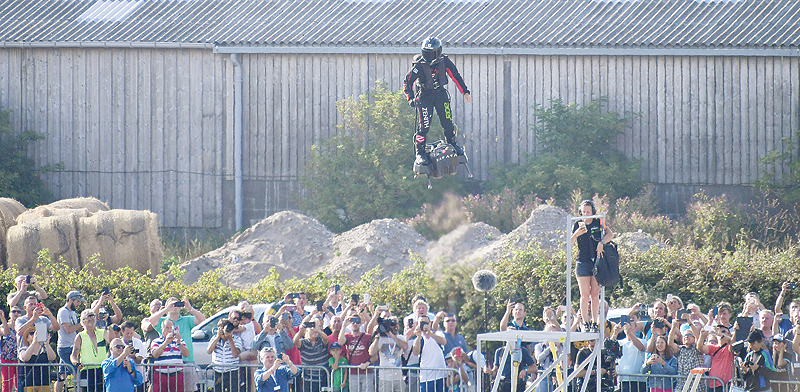A daredevil French inventor yesterday failed in his attempt to fly across the Channel standing on a jet-powered "flyboard", crashing into the sea but vowing to try again. Franky Zapata, 40, a former jet-skiing champion, had to be fished out of the Channel by rescuers after falling into the busy shipping lane between France and Britain during a tricky refueling manouevre. But Zapata, who suffered only a scratched elbow, said afterwards that while he was "disappointed" he would be having another go in the future.
Zapata took off successfully from Sangatte in northern France and had planned to land in Britain at St Margaret's Bay outside Dover after a flight of just 20 minutes. But the refueling was always set to be one of the most difficult parts of the operation and Zapata made contact with the refueling platform due to the waves, forcing him into the sea. "I am disappointed. Now it's certain that I will cross again but I don't know when. I will need to renegotiate with everyone," he told AFP after being taken back to France.
'Very, very fast'
Zapata had hoped to make the 35-kilometre (22-mile) crossing in 20 minutes, keeping an average speed of 140 kilometers an hour (87 mph) at a height of 15-20 meters (50-65 feet) above the water. The flyboard is fuelled by kerosene stored in the rider's backpack. Zapata carried 47 kilos (104 pounds) of it yesterday. But as that would only take him part of the way across the Channel, he needed to pick up a new backpack in mid-Channel for the second half of the trip.
"I think it was just a case of a few meters, even a few centimeters," said the mayor of Sangatte, Guy Allemand, after the mid-Channel mishap was confirmed. "Divers jumped right out of the boat to get him back. It was very, very fast," he told AFP. In a scene resembling a science fiction film, Zapata had zoomed into the sky at the start of attempt wearing a full body suit, helmet and clutching a joystick to control the device.
Onlookers in Sangatte gasped in astonishment as he soared high above the sea and rapidly became just a tiny speck on the horizon. In a tribute to past aviation heroes, Zapata had picked the day that marks 110 years since pioneer Louis Bleriot made the first airplane flight across the Channel on July 25, 1909. His plan had initial snags as French maritime authorities refused to give the project their blessing-while stopping short of an outright ban-due to intense shipping traffic in the Channel. But the maritime authorities said they lifted their "unfavorable opinion" after receiving guarantees from Zapata about his refueling plans and safety. For making a new attempt, Zapata will likely have to open new talks with the authorities.
'Follow in the footsteps'
Zapata sprang to national prominence at the July 14 Bastille Day military parade when he soared above the Place de la Concorde in Paris in front of world leaders including President Emmanuel Macron and German Chancellor Angela Merkel. He carried a rifle during that demonstration and the French defense ministry said it was studying how the flyboard could be used by its troops. "We created a new way of flying.
We don't use wings. You are like a bird, it is your body that is flying. It is a boyhood dream," Zapata told reporters ahead of the Channel flight. "We want to follow a little bit in the footsteps of the pioneers of aviation," he added. Zapata's flyboard, which is about the size of a skateboard, is powered by five small jet engines that allow the rider to fly at speeds of 190 kilometers an hour (118 mph).-AFP











